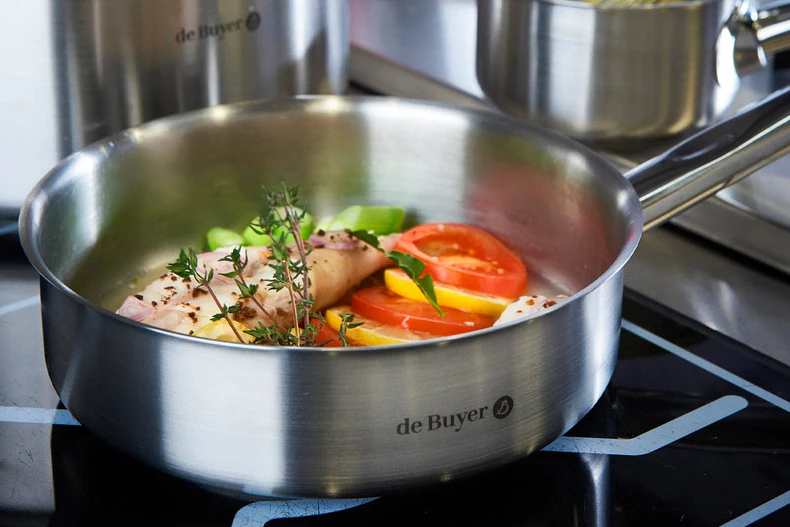The Ultimate Guide To Saute Pans + Which Pans To Buy
by Ellie Edwards

Discover what sets saute pans apart from other cookware, which pan to choose, and how to use your pan when cooking.
What is a saute pan?
A saute pan is an essential piece of cookware. Saute pans typically have straight sides and are deeper, compared to a frying pan which tends to have curved, slanted sides. Saute pans and frying pans can be used interchangeably, however a saute pan is perfect for the following uses:
- Browning meats for stews and casseroles
- Reducing sauces and warming through gravies
- Cooking risottos and pilafs
- Sauteing vegetables
- Making the perfect grilled cheese sandwich
The main benefit to the straight sides is that it is easier to keep liquid within the pan, and prevent spillages, perfect for cooking sauces. Another advantage of low, straight sides is that they prevent condensation and allow excess humidity to evaporate. This is essential for the Maillard reaction to occur – the reaction that gives browned and caramelised foods their distinctive flavour.
Some saute pans have curved sides. These pans are ideal for sauteing diced vegetables with a rolling, ‘flipping’ motion.
Conical saute pans are also popular for anything that might need a lot of stirring - making roux-based sauces, custards, risottos, even fudge! That's because the gently curved sides mean it's easy to move food away from corners during cooking.
Do you need a saute pan?
Saute pans are a great all-round piece of cookware. If you don’t have lots of space, saute pans are perfect - they can be used as you would a frying pan, but they’re deep enough for making sauces and stews. Saute pans come in all sizes and are made of different materials. And it’s likely to become the most used pan in your kitchen. Here’s what makes each saute pan unique:
The Alchimey saute pan is made from two layers of durable stainless steel with an aluminium core. This combination of materials means the pan is very reactive to temperature changes - the pan will heat up quickly, and cool down quickly when removed from heat, giving greater control with your cooking. The durable stainless steel also means this pan is long-lasting.
The ergonomically designed handle is cast from stainless steel and riveted to the pan for durability. Stainless steel is a poor conductor of heat so the handle will stay cool, and as the handle is riveted, the heat won't travel up as easily, making it easier to lift and hold.
This pan is also induction compatible.
The side lip on this deep saute pan with a lid makes it easy to carry straight to the table. Meanwhile, the long beechwood handle doesn’t conduct heat, so you can move the pan without needing a glove.
The glass lid means you can keep an eye on recipes as they cook, and also keep in extra heat for even cooking. You can use this pan on all types of hob, including induction, and the 5mm thick base means you get even heat distribution with no hot spots.
The De Buyer Prima Matera straight copper saute pan for induction is too good looking to hide away in a cupboard. It's the ultimate all-rounder.
The tremendous heat conduction qualities of copper mean the pan responds almost instantly to changes in temperature. This gives great control. Plus, riveted cast iron handles guarantee durability, and give this pan a traditional, timeless design.
The De Buyer Prima Matera conical copper saute pan is essential for cooks who make lots of sauces, gravies and jus. The shape of the pan allows for fast, efficient reduction of sauces. The small base heats up quickly, and the sides flare out to a wide mouth that provides a large surface area for evaporation.
How do I use a saute pan?
Saute pans are primarily for use on hobs. Depending on the material your pan is made of, it may also be oven safe.
How you use your saute pan also depends on what you’re cooking, so it’s always worth reading the recipe first! For warming through sauces, gravies and jus, you’ll want a medium heat and it’s important to keep stirring to prevent the liquid from catching.
For browning meat in a saute pan, you want to make sure the pan is very hot, add a little oil, space the chunks of meat apart in the pan, and leave until caramelised. You can shake the pan and gently flip the meat to brown all over.

About the author
Ellie Edwards is a food writer for Sous Chef. Previously she worked at olive magazine, writing about exciting new ingredients, UK restaurants and travelling the world to find the best cinnamon buns. When she's not exploring the likes of Belize, Kerala and Zanzibar, Ellie loves rustling up a feast in her London kitchen, with a particular passion for porridge, sourdough and negronis.






